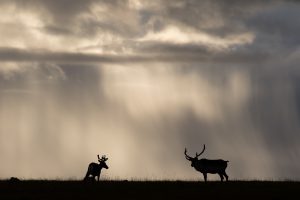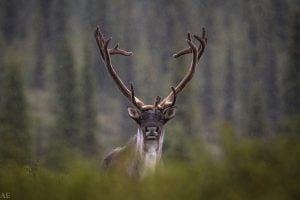Woodland caribou
By contrast, woodland caribou, R. caribou, are darker and on average 63 per cent bigger (males average 180 kg, up to 272 kg) than barren-ground caribou (males average 110 kg, up to 153 kg). Because males tend harems and defend them from other males, they have shorter, straighter, more robust, and bushier antlers designed for combat. DNA analysis shows woodland caribou diverged from primitive ancestors of barren-ground caribou, not during the last glacial maximum, 26,000 to 19,000 years ago, as previously assumed, but in the mid-Pleistocene, around 357,000 years ago. At that time, modern tundra caribou had not yet evolved. Woodland caribou are likely more closely related to extinct forest caribou species than to barren-ground caribou. For example, the extinct species Torontoceros [Rangifer] hypogaeus, had features (robust and short pedicles, smooth antler surface, and high position of second tine) that relate it to forest caribou. This being the case, woodland and barren-ground caribou cannot be the same species because they do not share a direct ancestor. Genetic distance between barren-ground and woodland caribou, as shown by many studies over the last 19 years, confirms them as separate species. Labrador or Ungava caribou, and Newfoundland caribou, although genetically, ecologically and behaviourally distinct from boreal woodland caribou, share the same ancestral lineage and are therefore subspecies of woodland caribou.
Likewise, in Eurasia, forest reindeer, Rangifer fennicus, descend from a fossil reindeer, Rangifer guettardi, that lived in western European forests, whereas all tundra reindeer descend from another fossil species, R. constantini, that was adapted to grasslands. Since they do not share a direct common ancestor, they cannot be the same species.
What does this mean for caribou conservation?
In the 1990s, the B.C. government augmented a declining Selkirk Mountain caribou herd with about 130 Osborn’s caribou from the west-central part of the province. These are both subspecies of Arctic caribou. Osborn’s caribou evolved to migrate to low elevation all winter and paw through the snow for “reindeer moss,” a ground lichen that grows under dry lodgepole pine, but not in the moist cedar-hemlock and spruce-fir forests of the Selkirk Mountains. Unlike the Selkirk Mountain caribou, they did not have the instinct to migrate back to subalpine forest in mid-winter to forage arboreal lichens. No Osborn’s caribou survived a year. This is proof of reproductive isolation.
When two recognizably different kinds of animals—deer, sheep, monkeys, whatever—cannot interbreed even when put together, and cannot survive in each other’s habitats, they are different species, regardless of what definition of “species” is in vogue. With caribou, DNA has forced us to accept the obvious and recognize the diversity of our caribou.
Lee E. Harding has a BSc in Wildlife Management from Humboldt State University (California) and a PhD in Wildlife Toxicology from Gifu University (Japan). He consulted in wildlife ecology in the Arctic for five years, was an Environment Canada biologist and program manager for 21 and, after taking early retirement from the Canadian Wildlife Service, was an environmental consultant for another 20 years. Dr. Harding is a Registered Professional Biologist in British Columbia, Canada and a member (retired) of the British Columbia College of Applied Biology, the American Society of Mammalogists and the British Columbia Field Ornithologists. His recent publications have included several journal articles on caribou.








